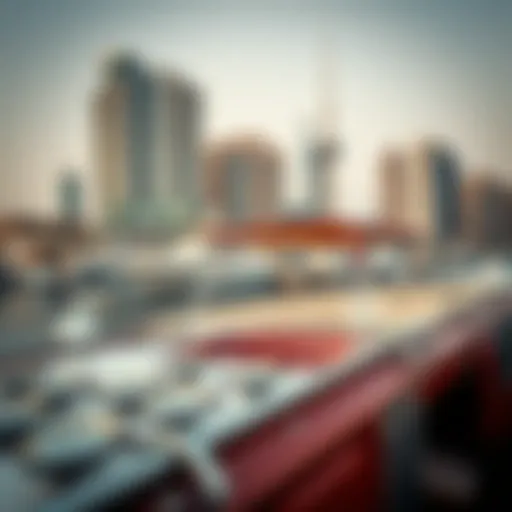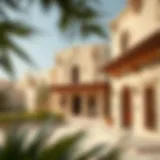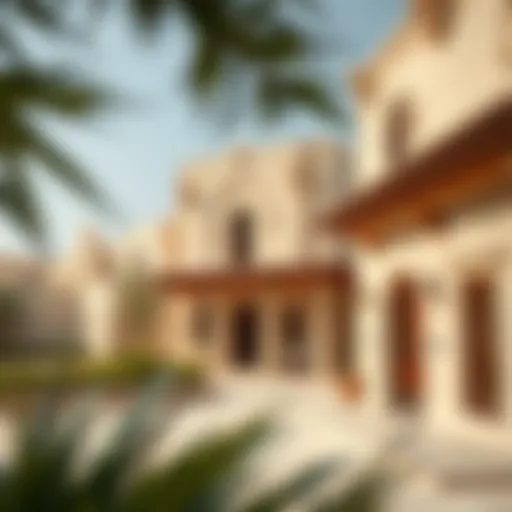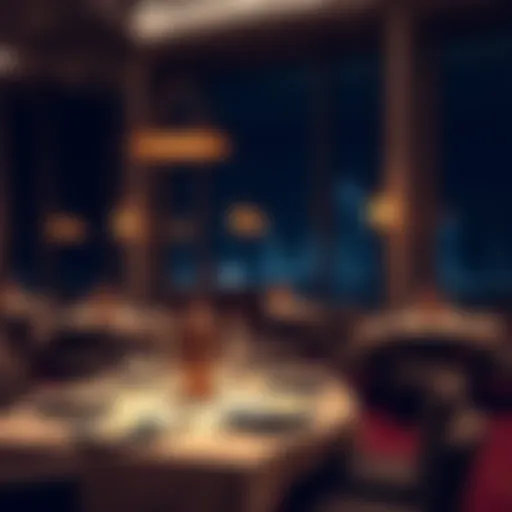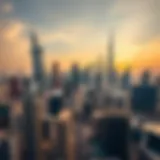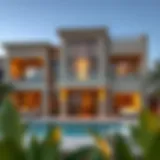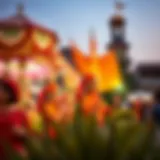Exploring Aesthetic Dimensions in Dubai's Real Estate


Intro
Dubai has always been a city where modernity meets tradition, a canvas that artists of architecture have colored with their creative strokes. In the realm of real estate, aesthetics play a pivotal role, shaping not only the skyline but also the experiences of those who inhabit this vibrant metropolis. The luxury living spaces here go beyond mere functional design; they are manifestations of opulence and cultural sentiments, delicately woven into the very fabric of urban life. Understanding how these aesthetic dimensions influence property design, urban planning, and lifestyle can significantly enlighten property enthusiasts and investors, making them better informed in their decisions.
In the following sections, we will explore current trends in Dubai's real estate market, delve into iconic luxury developments, and offer a guide to investing in such properties.
Market Trends and Insights
Current Trends in Dubai Real Estate
The real estate market in Dubai is like a constantly shifting desert landscape; changes are rapid and influenced by various socio-economic factors. Recently, the rise of eco-friendly designs has made quite a splash. With sustainability in the spotlight—as it rightly should be—many new developments are incorporating green technologies and materials, helping to reduce their carbon footprint.
Moreover, the blending of traditional Islamic architecture with contemporary styles is captivating the eye. This fusion creates not just buildings but spectacles that tell stories of a rich cultural heritage alongside modern innovation. For instance, the use of intricate geometric patterns and vibrant colors resonates with the city’s cultural roots while also appealing to a global audience.
Another noteworthy trend is the increasing demand for smart homes. As technology advances, potential buyers are drawn to properties that offer integrated systems for security, lighting, and climate control, enhancing both convenience and luxury.
Predictions for Future Market Developments
Looking ahead, experts anticipate that the real estate market in Dubai will continue its upward trajectory, albeit with a more conscious eye on aesthetics and sustainability. The push for luxury and high-end developments is unlikely to wane, particularly as the governing bodies in the UAE promote tourism and business hubs.
Furthermore, the smart city initiative will likely progress more rapidly, fueling interest in properties that seamlessly merge technology with lavish comfort. As Dubai positions itself as a technological innovation leader, properties equipped with Internet of Things (IoT) capabilities can expect to capture the attention of savvy investors.
Luxury Developments and Properties
Spotlight on Iconic Developments
Some of the noteworthy gems that glitter in Dubai’s real estate landscape include the Burj Khalifa, Palm Jumeirah, and the upcoming Dubai Creek Tower. These structures are more than mere buildings; they exemplify the ambitions of a city striving to reach new heights, both literally and metaphorically.
A prime example is the Burj Al Arab, often dubbed the world's only 7-star hotel. Its sail-like silhouette is not just attractive, but it reflects the luxury and indulgence synonymous with Dubai. Each property is designed with exquisite attention to detail, evoking a sense of grandeur and splendor.
Investing in Luxury Properties: A Guide
Investing in luxury real estate in Dubai requires a thoughtful approach. Key considerations should include:
- Location: Proximity to landmarks, amenities, and transport links can greatly influence property value.
- Developer Reputation: Look for established developers with a history of successful projects.
- Features and Amenities: Properties that offer unique features, such as waterfront views or bespoke designs, generally yield better returns.
It's essential to conduct thorough due diligence, including market research and financial assessments. Understanding the nuances of the Dubai market can be the golden key to unlocking potential investment opportunities.
"In the heart of the desert, beauty emerges not merely from visions of grandeur, but also from cultures interwoven in every design."
As we continue to uncover the aesthetic layers of Dubai's real estate, it becomes evident that the interplay between design, culture, and lifestyle creates a unique living experience that appeals to both residents and investors alike.
For more insights on Dubai’s real estate investment opportunities, you may want to explore Dubai Land Department, which offers a wealth of information on legal frameworks, property registration, and market research. Additionally, Wikipedia provides a comprehensive overview of the real estate landscape in the UAE.
Prelude to Aesthetics in Real Estate
In the bustling heart of Dubai, the real estate landscape is not just a set of buildings; it embodies the essence of aesthetics. The importance of aesthetics in this sector cannot be understated. It blends culture, design, and functionality into a visual and experiential narrative. While many investors focus solely on the financial aspects, dismissing aesthetics could be a missed opportunity. The allure of a home or commercial space often lies in how its design resonates with potential buyers.
Defining Aesthetic Value
Aesthetic value isn't just about beauty. It encompasses proportion, scale, harmony, and even individuality. What makes a structure appealing can differ drastically among various stakeholders. For a residential buyer, it's about warmth and comfort. A corporate investor might prioritize sleek modernity and functionality. Aesthetic value acts as a bridge, connecting these diverse perspectives.
For instance, take the iconic Burj Khalifa; its unique silhouette and stunning facade symbolize not just architecture but also ambition. Moreover, aesthetic value helps differentiate a property in a saturated market. When homes have a unique visual identity, they stand out, attracting discerning buyers.
The Importance of Aesthetics in Property Investment
When it comes to property investment, aesthetics plays a crucial role. Buyers' emotional responses to a property often sway their decisions. Spaces that evoke positive feelings can command higher prices. Studies suggest that a well-designed home can appreciate at rates surpassing the market average simply by virtue of its aesthetic appeal.
- Buyers often pay a premium for homes with distinctive architecture.
- High-quality design can reduce vacancy rates in rental properties.
- Well-planned communal aesthetics can foster a sense of belonging in neighborhoods.
Moreover, aesthetics can guide investors in predicting trends. For example, properties that incorporate cultural elements are increasingly sought after. As global influences blend with local traditions, understanding this shift can be key to successful investments.
"In the world of real estate, aesthetics isn't just a fancy finish; it's a business strategy that creates value beyond the tangible."
In essence, embracing aesthetics not only enhances gut feelings but also serves as a calculated method for long-term investment success. Investors who fully appreciate the aesthetic dimensions of their properties often find themselves a step ahead in Dubai's dynamic real estate scene.
Stay with us as we further explore the architectural styles that paint the skyline of this thriving metropolis.
Architectural Styles in Dubai
Dubai’s architectural styles tell a compelling story—one that blends cultural heritage with modern innovation. In a city that is ever-evolving, skyscrapers scrape the sky while traditional designs harken back to the region’s rich history. Understanding these architectural influences is more than a mere exploration of aesthetics; it’s about grasping how these styles reflect societal values, investment potential, and lifestyle options available to residents and investors alike.


Contemporary Designs
Contemporary design in Dubai focuses on sleek lines, open spaces, and a strong embrace of natural light. This style often prioritizes functionality and minimalism, appealing to those who appreciate modern living while still desiring elegance. Buildings like the Burj Khalifa and the Dubai Mall showcase this aesthetic, offering expansive interiors and state-of-the-art amenities.
Benefits of contemporary designs include increased energy efficiency and space optimization. Expansive glass facades not only enhance the visual appeal but also help reduce energy costs through natural illumination. Investors taking a keen interest in such properties can expect a favorable return, particularly as environmentally sustainable design continues to gain traction.
Key features of contemporary designs:
- Open-plan layouts that encourage social interaction
- Integration of smart technology for enhanced convenience
- Use of eco-friendly materials that appeal to modern sensibilities
"Dubai’s contemporary architectural style is a fusion of luxury, practicality, and artistic expression—reflecting a desire for progress while respecting tradition."
Traditional Influences
While contemporary designs dominate the skyline, traditional influences remain integral to Dubai's identity. Buildings reminiscent of Islamic architecture—characterized by intricate geometric patterns, arabesques, and majestic domes—tell the stories of generations past. Structures like the Al Fahidi Historical Neighborhood showcase these designs, where narrow lanes and wind towers remind us of a time when cooling methods reflected ingenuity.
Traditional architecture highlights community values and reflects the cultural significance of craftsmanship. Homebuyers looking for properties with historical flair often gravitate towards these designs, combining luxury with cultural appreciation.
Considerations about traditional influences:
- Preservation of cultural heritage, which resonates with expats and tourists
- Strong resale value due to historical significance
- Increasing demand for unique properties that offer character and story
Futuristic Concepts
Futuristic concepts in Dubai are not merely a trend; they embody a vision of what urban living might look like in the years to come. Architectural marvels like the Museum of the Future illustrate innovation in both design and purpose. These properties often incorporate eco-friendly technologies, adaptable spaces, and biophilic elements that connect residents with nature.
These futuristic designs reflect the city’s ambition and forward-thinking mentality. Investors keen on aligning their portfolios with trend-setting developments may find these concepts appealing. As Dubai continues to position itself as a global hub, properties that embody a visionary aesthetic are likely to draw significant interest.
Key aspects of futuristic concepts:
- Integration of renewable energy sources
- Designing adaptable spaces that reflect changing lifestyles
- Creating environments that promote sustainability and community engagement
Materials and Aesthetic Appeal
Materials play a pivotal role in shaping the aesthetic appeal of real estate. In a city like Dubai, known for its opulence and cutting-edge designs, the selection of materials is not just a matter of function; it transforms spaces into visual and sensory experiences. These choices reflect the ethos of luxury, sustainability, and cultural significance, impacting both the architectural narrative and buyer perceptions. In this high-stakes market, where trends evolve as swiftly as the skyline, understanding this dimension can inform sound investment decisions and enhance the overall living experience.
The Role of Luxurious Materials
Luxurious materials serve as the backbone of aesthetic allure in Dubai's real estate sector. Think of marble, precious woods, and rich metals—all of which contribute to a sense of grandeur in homes and commercial spaces. When a buyer steps into a lobby adorned with Italian marble floors or a penthouse featuring teak balconies, it’s an experience that goes beyond mere visuals.
- Perception of Quality: High-end materials evoke feelings of exclusivity; they tell a story of craftsmanship and attention to detail. For instance, Burmese teak is often chosen for its durability and striking patterns, imbuing properties with an aura of elegance.
- Symbol of Prestige: The use of luxurious materials often signals a status symbol. Properties that incorporate these elements command higher market values and attract discerning buyers who appreciate sophistication.
- Increased Lifespan: There's also a practical aspect; top-tier materials typically offer greater longevity and resistance to wear and tear, translating to lower maintenance costs over time. These factors combine to enhance desirability in a competitive market.
"The materials used not only elevate aesthetic appeal but also communicate the lifestyle aspirations of residents."
Sustainable Material Choices
Sustainability is not just a trend; it's becoming a necessity in modern real estate. As environmental awareness grows, consumers increasingly demand properties that reflect eco-friendly practices. Utilizing sustainable materials is a meaningful way developers can contribute to a greener future while still catering to the luxury market.
- Reinforcement of Brand Values: Developers incorporating eco-conscious materials, such as recycled steel or bamboo, boost their brand's reputation among investors prioritizing environmental stewardship.
- Energy Efficiency: Materials that promote energy efficiency—like insulated glass or solar panels—can lead to substantial long-term savings. Properties fitted with these elements often advertise lower utility costs, appealing to both investors and end-users.
- Unique Aesthetics: Eco-friendly options don't mean sacrificing beauty. Reclaimed wood or recycled aggregates can add character to a design, creating unique textures and tones that stand out in standard luxury homes.
In order to navigate the complexities of material selection, real estate professionals should seek resources from sustainable building organizations or consult educational platforms like Green Building Council for best practices in integrating these materials into projects. Linking sustainability with luxury culminates in a compelling story—one that draws in sophisticated buyers eager to invest in properties that align with their values.
The choice of materials can transform the face of Dubai's real estate, turning simple structures into breathtaking monuments to luxury and sustainability.
Urban Planning and Aesthetic Integration
In the bustling context of Dubai’s real estate market, the intersection of urban planning and aesthetics holds paramount importance. It's not just about erecting buildings; it's about creating a harmonious environment where functionality meets visual appeal. The delicate balance of utility and beauty shapes not only the skyline but also the lifestyle of its inhabitants. The interplay between these two elements can determine how spaces are perceived and utilized, making it a critical area of focus for stakeholders in the property development realm.
Public Spaces and Visual Cohesion
Public spaces are the heart and soul of urban environments, and in a city like Dubai, they serve as gathering points that reflect the city's identity. The architectural identity built within these realms often correlates directly with how aesthetically pleasing they are to the residents and tourists alike. Well-integrated public areas like parks, plazas, and waterfronts enhance the overall visual cohesion of the community.
In Dubai, the role of these spaces is quite significant. Consider the Al Seef district. It blends traditional Emirati architecture with modern facilities along the picturesque Dubai Creek. This not only draws attention but also offers a functional space that brings communities together. The sites serve as venues for local events, art displays, and gatherings, reinforcing the idea that aesthetic integration in planning can foster community engagement.
"Public spaces are not just physical locations; they are social connectors, fostering interaction and cultural exchange."
Key elements in achieving visual cohesion include:
- Consistent Design Language: Using a uniform style across buildings in close proximity can create a seamless visual experience.
- Landscaping: Thoughtful landscaping, from potted plants to larger green areas, enhances the aesthetic worth and makes spaces hospitable.
- Accessibility: Easy access points between public spaces and nearby buildings encourages foot traffic, increasing communal activity.
The aesthetic quality of public spaces establishes an emotional connection with users. It’s essential that urban planners consider how designs will be perceived at different times of the day and how they might evolve with changing demographics.


Navigating Material and Design in Community Planning
When we discuss community planning in Dubai, the materials and architectural design play crucial roles in embodying the desired aesthetic expression. The use of striking materials, such as glass and steel juxtaposed with traditional clay and stone, offers a unique conversation between the past and future. This dialog becomes essential in creating spaces that are not only functional but also hold deep aesthetic value.
Community planning requires a thoughtful approach. Key considerations include:
- Environmental Sync: Materials chosen must also take into account weather conditions, energy efficiency, and sustainability. Using locally sourced materials can reduce environmental strain and cultivate a connection with the land.
- Design Versatility: A successful community design must incorporate a variety of design styles while ensuring they complement each other. A mishmash of aesthetics can lead to disjointed spaces that fail to attract buyers or residents.
- Cultural Relevance: Incorporating local cultural elements within material choices can help ensure that developments resonate with existing community sentiments. This means being receptive to local tastes while also innovating.
Ultimately, navigating the choices of material and design affects both the aesthetic appeal and functionality of community projects. As Dubai continues to evolve, embracing aesthetics within urban planning will be key in creating residential and commercial areas that feel both luxurious and welcoming.
Aesthetic Trends in Luxury Developments
The realm of luxury real estate in Dubai is not just about high prices and extravagant features; it revolves significantly around aesthetic trends that define living experiences. In a city where opulence knows no bounds, the aesthetics of luxury developments play a critical role in satisfying buyers and investors alike. Understanding these trends is paramount for anyone looking to navigate the Dubai property market effectively.
One noteworthy trend is the focus on high-end amenities that elevate the overall aesthetic experience of a property. From infinity pools adorned with elegant tiles to lush landscapes that echo tranquility, amenities are designed not just for utility but for visual pleasure. Buyers are increasingly looking for properties that offer more than just a roof over their heads. They want experiences wrapped in aesthetics. A rooftop garden can be just as appealing as a state-of-the-art gym; both are crucial in cultivating a luxurious lifestyle.
- Infinity pools and spa-like features contribute significantly to the overall feel of a property.
- Smart home systems that integrate design with function enhance both efficiency and aesthetics.
- Sustainable amenities, such as green roofs, can create a striking visual while benefitting the environment.
These elements align luxury with sustainability, addressing both the consumer’s demands and the societal trends towards eco-friendliness.
High-End Amenities and Aesthetic Sophistication
The incorporation of high-end amenities is more than just an added benefit; it's a hallmark of sophistication that distinguishes high-value properties in Dubai. These are not merely extras, but essential components that create a luxurious living environment.
For instance, consider properties in the Dubai Marina, known for breathtaking views and leisure options like high-rise pools. Such spaces are designed to foster communities while also providing serene escapes for residents. Here are a few corners of luxury you’ll often find:
- Wellness centers that offer retreats from the bustling city life.
- Exclusive lounges and entertainment areas where residents can interact and unwind.
- Private cinemas and gaming zones that blend technology with lifestyle whims.
These amenities provide residents with more than just function; they create an atmosphere that promotes connectedness and self-indulgence. A property with such offerings becomes not merely a place to live but a statement of lifestyle and success.
Art and Aesthetic Experience in Properties
Art can often be the invisible thread that ties a property’s aesthetic together. In the luxury market, art isn’t merely decor; it has become an integral part of the fabric of a home. Many developers collaborate with local and international artists to bring bespoke artistic touches into their properties, curating an aesthetic experience that resonates with the elite tastes of buyers.
- Sculptural elements in lobbies and outdoor spaces that captivate as soon as one steps inside.
- Wall installations or commissioned pieces that can elevate interior spaces significantly.
- Exhibitions organized in common areas, allowing residents to engage with art in their everyday lives.
These artistic integrations emphasize a broader narrative: properties in Dubai are not just functional but serve as canvases that reflect personal identities and cultural dialogues. Having art within a home creates a multisensory experience, enriching the aesthetic appeal and making a powerful statement about both luxury and lifestyle.
"In Dubai, the convergence of art and luxury real estate is not just an opportunity; it is a necessity that enriches the living experience."
In summary, aesthetic trends in luxury developments in Dubai intertwine high-end amenities and art, forming an intricate web of luxury lifestyle that attracts discerning buyers. As expectations rise, the property market responds with innovative designs and exquisite features, turning living spaces into distinctive aesthetic journeys.
Cultural Significance of Aesthetic Choices
The cultural significance of aesthetic choices in Dubai's real estate landscape reveals layers of meaning that influence not only architectural designs but also the identity of community life. This aspect is vital for investors, homebuyers, architects, and anyone navigating the intricate relationship between habitat and heritage. By comprehending the aesthetic inclinations molded by diverse cultural narratives, stakeholders can appreciate the depth of their investments while enhancing community engagement.
The selections made in the realm of aesthetics speak volumes about societal values and shared history. They serve as a canvas that captures the essence of local identity, often blending historic sensibilities with modern aspirations. In a city like Dubai, where the past and future contrast vividly, the architecture speaks both the language of tradition and contemporary relevance effectively.
- Identity Representation: Each design choice echoes the collective memory of the community. The materials, colors, and forms utilized can illustrate the stories of the people who inhabit these spaces. For investors, understanding this representation informs marketing strategies that resonate with buyers.
- Emotional Connection: A thoughtfully designed space can evoke feelings of pride and belonging. For the local populace, these environments provide a sense of security, while for expatriates, they foster a connection to the city. Such emotions can ultimately affect property valuation and desirability.
- Cultural Celebrations: The designs sometimes become the locus of cultural events, festivals, and traditions. Buildings may house art installations or perform as backdrops for community gatherings, thus enhancing their aesthetic appeal while solidifying cultural relevance.
"Architecture is a visual art, and the buildings speak for themselves."
— Julia Morgan
In summary, the integration of culture within aesthetic choices not only enriches the physical environment of Dubai but also provides investors and residents alike a platform to engage with their identity on multiple levels. The journey of exploring this significance rewards one with profound insights into how aesthetics shape urban living.
Reflecting Cultural Heritage through Design
Design in Dubai often serves as a narrative thread linking past, present, and future. The choice of materials and styles is not arbitrary; it derives from an inherent respect for heritage. Islamic motifs, traditional wind towers, or the curvature of a desert dune are more than visual elements; they symbolize a communion with the land's cultural history.
Take, for instance, the Al Fahidi Historical Neighborhood, which showcases wind tower houses that have been meticulously preserved. Visitors and residents experience a slice of Dubai's past while standing in front of contemporary marvels like the Burj Khalifa. Here, heritage does not clash with modernity—it thrives alongside it, creating a hybrid aesthetic that enhances the city's charm. By intertwining these historical elements into contemporary designs, developers can elevate property appeal, leading to increased demand.
Global Influences on Local Aesthetics
As a melting pot of cultures, Dubai's aesthetics are significantly impacted by global trends. This is evident in high-rise developments mimicking international styles, such as the clean lines typical of Nordic architecture or the flamboyant forms from South American designs.
Yet, it's not a straight transplant. Developers adapt global influences to resonate with local identities. A quintessential example is the integration of sustainability into aesthetic choices, reflecting a more extensive shift in global architecture toward eco-friendliness. Using local materials blended with global techniques allows for a unique aesthetic—one that respects local context yet embraces international standards.
For instance, consider the use of environmentally friendly materials in properties designed with sleek glass facades. It's a fashion statement but serves pragmatic purposes like energy efficiency. The result is an aesthetic that tells a story of global connectivity while being mindful of local heritage.
The influence from outside not only enhances aesthetic diversity but also enriches the property's marketability, attracting buyers looking for unique living experiences blended with cultural significance. Understanding these dynamics aids potential investors in making informed choices, recognizing properties not merely as buildings but as narratives interwoven with local and global histories.
Consumer Preferences and Aesthetic Appeal
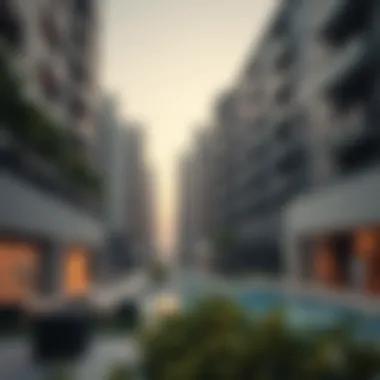

In the bustling real estate landscape of Dubai, where luxury and innovation hold sway, understanding consumer preferences becomes a pivotal element of aesthetic appeal. As buyers navigate this vibrant market, their expectations are shaped by a myriad of factors, from cultural influences to design trends. Being attuned to these preferences not only enhances the appeal of properties but also influences investment decisions significantly. This section will explore how aesthetics amalgamate with consumer desires to create a unique property market.
Understanding Buyer Expectations
When it comes to real estate in Dubai, buyers are not simply seeking a roof over their heads; they desire experiences that reflect their lifestyle aspirations. This is particularly true for high-end buyers, who often have specific expectations shaped by global design trends, cultural backgrounds, and personal tastes.
For instance, many buyers may be drawn to properties that highlight sleek, minimalist designs, as these often evoke a sense of modernity and sophistication. On the other hand, there are those who crave designs that incorporate traditional Arab elements, providing a sense of cultural depth and heritage.
Moreover, sustainability has now become a crucial part of buyer expectations. With an increasing awareness of environmental impact, many property buyers now prioritize sustainable design elements.
- Customization: Buyers often look for properties that offer a degree of customization. Flexible layouts, which allow for personal touches, are more attractive.
- Technology: The integration of smart home features is no longer a luxury but an expectation. Buyers now anticipate homes equipped with the latest technology for comfort and automation.
With these factors in play, property developers and realtors must align their offerings with these evolving expectations to stand out in the competitive market.
The Impact of Aesthetic on Property Value
The aesthetic appeal of a property can directly influence its market value, making it a crucial consideration for both buyers and sellers. Well-designed properties not only attract attention but also command higher prices due to their perceived value.
Key Impact Factors Include:
- First Impressions Matter: The initial visual impact of a property affects buyer perception right from the first glance. A striking façade or beautifully maintained landscape can significantly elevate initial interest.
- Higher Sale Prices: Properties that are aesthetically pleasing tend to sell for higher prices. A report by the National Association of Realtors indicated that modernized and aesthetically appealing homes can fetch as much as 10-20% more than their less visually appealing counterparts.
- Buyer Portfolio Preferences: Investors are increasingly viewing aesthetics as a part of their asset portfolio. Properties that combine high aesthetic values with functional design are considered more desirable investments.
To illustrate this point, let’s examine recent luxury developments in Dubai, where projects with unique architectural styles and high-end finishes have repeatedly surpassed their projected market value. Buyers are often willing to stretch their budgets for a property that resonates with their aesthetic sensibilities, which means that developers who prioritize design not only enhance customer satisfaction but also boost their bottom line.
Interestingly, aesthetics can also play into the narrative of a property. Storytelling through design can create emotional connections, allowing buyers to envision their lives within a space, thereby further enhancing value.
"A property that tells a story, resonates emotionally, and stands out in design, will always find its market."
In a city like Dubai, where competition is fierce and luxury is paramount, aligning consumer preferences with aesthetic appeal is not just beneficial; it’s essential. The ability to balance both elements can lead to more successful real estate ventures, ensuring that properties are not only seen but desired.
Challenges in Maintaining Aesthetic Standards
The beauty of Dubai's skyline and its residential areas is often on the tip of every tongue, but behind that allure lies a complex tapestry of challenges that must be navigated to maintain aesthetic standards. These challenges are crucial to understand as the city continues to grow and evolve. Real estate investors, homebuyers, and architects all must consider both the environmental and functional aspects of design to achieve a harmonious balance in this thriving metropolis.
Balancing Functionality and Aesthetics
When designing properties, the marriage of functionality and aesthetics is no small feat. For example, a residential building may boast an exquisite facade made from elegant glass and steel, but if the internal layouts are awkward or inefficient, the property can struggle to attract buyers. It’s essential that developers engage wisely with architects and designers to ensure that beauty doesn’t eclipse practicality.
In some cases, you might have properties that appear stunning from the outside but are essentially unlivable once you step inside. On the other hand, practical designs with minimal frills may not evoke that luxurious feel that the Dubai market craves. A balancing act is needed—creating spaces that are not only visually appealing but also serve their intended purpose effectively.
The Future of Aesthetics in Dubai’s Real Estate
The look and feel of properties in Dubai are constantly evolving, driven not just by trends but also by changing buyer expectations. In this vibrant city, the future of aesthetics in real estate holds great significance. The aesthetic choices made today can influence property value, buyer interest, and overall lifestyle satisfaction down the road. Investors, homebuyers, and realtors are increasingly looking to understand how aesthetic trends align with emerging needs and preferences, shaping not just individual properties but entire communities.
Emerging Architectural Trends
Architectural trends are gaining momentum, reflecting a blend of functionality and style. The future doesn’t just focus on looking good but also encourages smart design that enhances quality of life. One notable trend is biophilic design, which integrates natural elements into buildings. This approach emphasizes the connection between people and nature, fostering a sense of tranquility and well-being.
Another intriguing trend is the use of parametric design, a style that prioritizes fluid shapes and adaptive uses of space. It allows architects to create structures that can evolve based on their environment or the needs of their occupants. This flexible approach is particularly appealing in a place like Dubai, where landscapes can change rapidly as new developments arise.
Furthermore, sustainable architecture is becoming a cornerstone of design philosophy. The future holds a promise of buildings that not only minimize environmental impact but also enhance energy efficiency through smart technologies. Materials like recycled aluminum and solar glass are gaining traction, marrying sustainability with cutting-edge aesthetics.
- Example of biophilic design: Indoor gardens within luxury condos.
- Example of parametric design: The twisting tower of the Cactus Tower.
- Example of sustainable architecture: The The Sustainable City, promoting eco-friendly living.
"Architecture should speak of its time and place, but yearn for timelessness." - Frank Gehry
Anticipating Lifestyle Changes and Aesthetic Expectations
As society evolves, so do the aesthetic expectations of buyers in the real estate market. Recent years have seen a surge in demand for properties that offer more than just a place to live. Homebuyers are increasingly focused on lifestyle—it’s all about finding a space that reflects their values and aspirations.
Key lifestyle shifts include a heightened awareness of wellness, a growing desire for multifunctional spaces, and an emphasis on community connectivity. For instance, properties that seamlessly integrate home offices and recreational spaces are becoming highly sought after. This reflects a trend where flexibility in living space is paramount, allowing residents to adapt their home environment to suit their lifestyle—whether that’s working from home or hosting social gatherings.
Accessibility to amenities such as parks, gyms, and communal areas is another vital aspect driving aesthetic choices. Properties that prioritize wellness and leisure can expect to fetch higher prices in the market, as buyers see value in environments that promote a healthy, active lifestyle.
Closure
In the ever-evolving world of Dubai's real estate, aesthetics are not merely a design choice; they are the soul that breathes life into structures, shaping the experiences and environments that define luxury living. The significance of this aspect cannot be overstated. Aesthetic considerations influence not only the initial appeal of a property but also its long-term value and desirability in a competitive market.
Recap of Aesthetic Importance in Real Estate
Throughout this article, we’ve explored the vital role aesthetics play within real estate in Dubai. At its core, aesthetic value enhances the marketability of properties. Buyers are drawn not only to locations, but also to the emotions evoked by beautiful environments. Developers who prioritize aesthetics often find themselves rewarded with higher sales and premium listings. For instance, properties designed with harmonious proportions and thoughtful use of light tend to create an inviting atmosphere that resonates with potential buyers, thus bridging the gap between mere structure and livable art.
Consider the impact of culturally inspired designs. When buildings reflect local heritage or global trends, they position themselves as more than just homes or commercial spaces; they become experiences that tell a story, enriching the lifestyle of their inhabitants.
Final Thoughts on Aesthetics and Luxury Living
In a city known for its opulence, the integration of sustainable materials and innovative designs will undoubtedly shape the next wave of development. The focus will likely shift toward how these choices enhance the overall living experience, making homes not just places to reside, but sanctuaries that offer an aesthetic refuge.
To conclude, the intersection of aesthetics and real estate in Dubai confirms a simple yet profound truth: when beauty and functionality unite, they create spaces that elevate everyday life. This blending of form and function not only attracts discerning investors but also enriches the cultural fabric and lifestyle of the vibrant city of Dubai.

